There’s a million ways to excel at customer service leadership to manage large support teams.
But not everything helps you become a good manager and get the results you want.
To succeed in managing successful teams and achieving the desired results for your organization, it’s essential that you stay ahead of the game.
We’ve talked to a couple of experienced professionals in the customer service space to get a realistic look at how you can make managing support teams effective.
Keep improving your internal communication efforts
One key way in which managers can achieve high-performing teams is by improving their team’s communication efforts. Regular meetings help keep everyone up-to-date with progress, while frequent feedback helps employees feel comfortable and encouraged to strive for better results.
Customer service leadership should aim to maximize the impact of their efforts by having clear, concise messages that go straight to the point. This leads to improved morale and increased efficiency among members of the customer service team, which positively impacts the overall performance of the business.
Milda Povilaitytė, Director of Customer Success at Whatagraph uses the following three-step structure to get emotional buy-in and hold open feedback sessions:
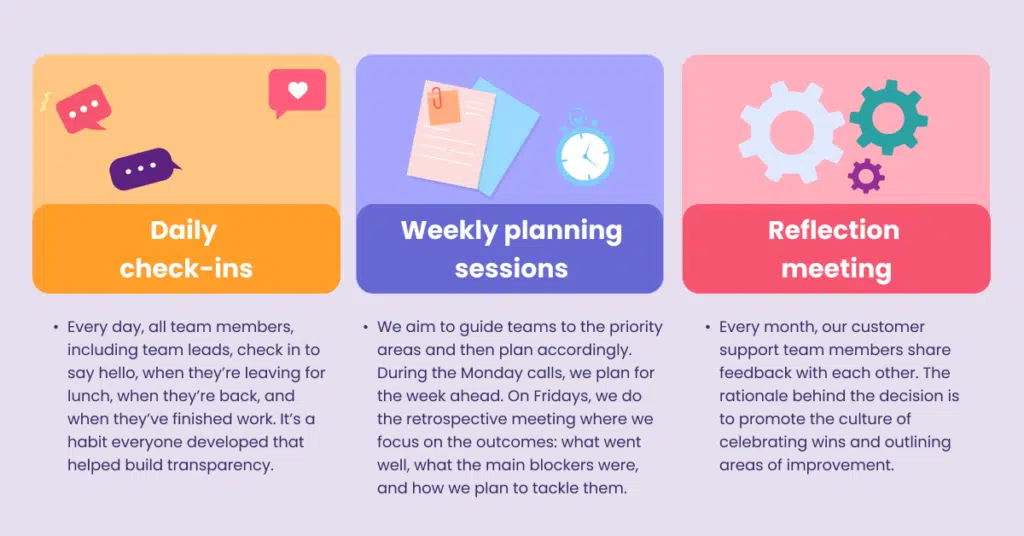
Letting your team contribute to the company strategy and culture
It’s crucial to support everyone to express their ideas and involve junior staff in the decision-making process. Customer support agents feel rewarded when their suggestions are implemented. Plus, you’re well on your way towards fostering a culture of evaluating and refining departmental practices.
Melissa Hughes, Customer Support Associate at Fetch Package, says she feels valued at work when managers listen to her ideas:
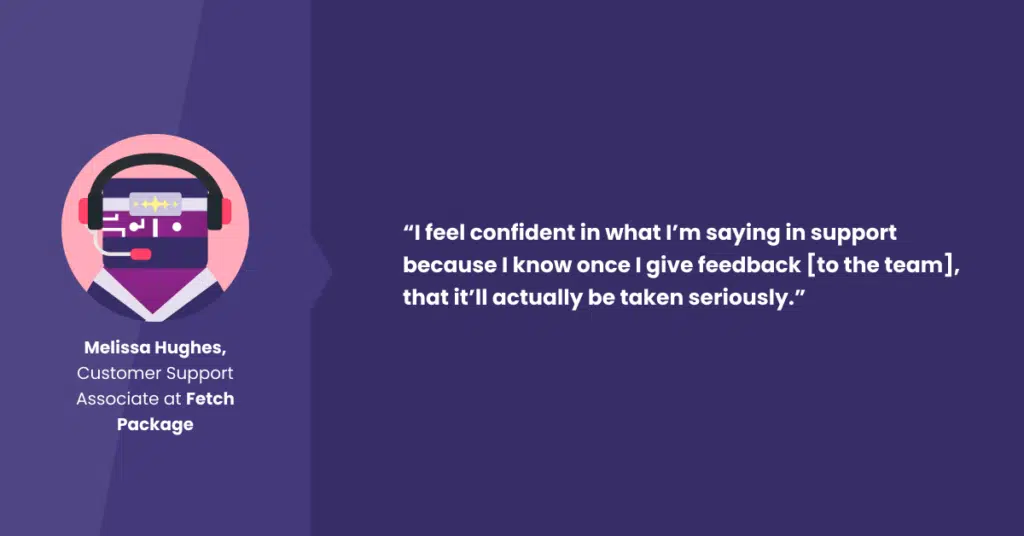
Rui Chaves, Global Director of Customer Support at Bolt, also shares his own preference for leadership styles in customer service and thoughts on the value of allowing your team to be a part of your decision-making process:
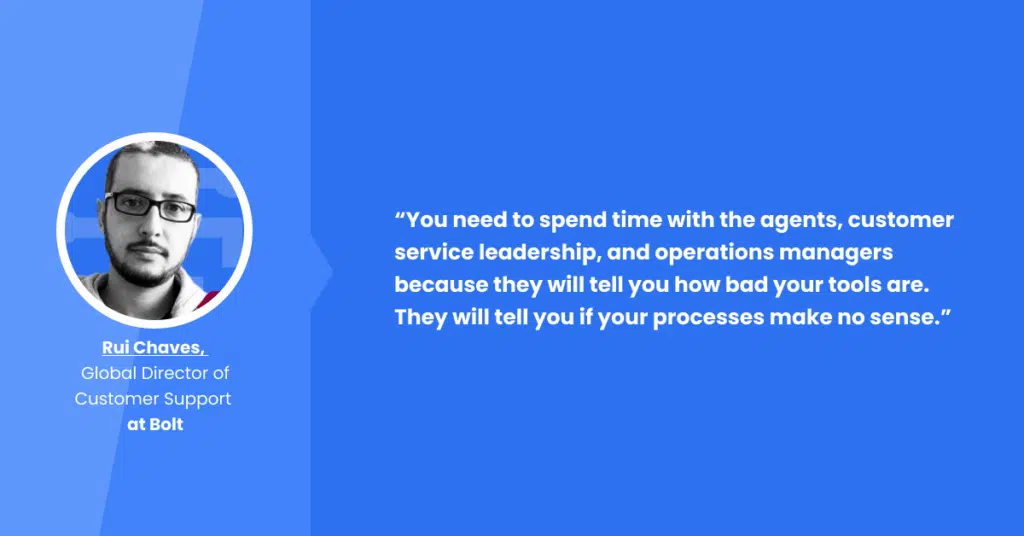
Building thoughtful onboarding program for new hires
On the same note of setting the stage from day one, a well-organized training agenda during onboarding is crucial. It can help new agents get up to speed with your best practices and product while also providing a general orientation on what to expect after the training.
Maryna Paryvai, Manager of Customer Support at Banzai, recommends organizing training programs by day with a specific (and busy!) agenda:
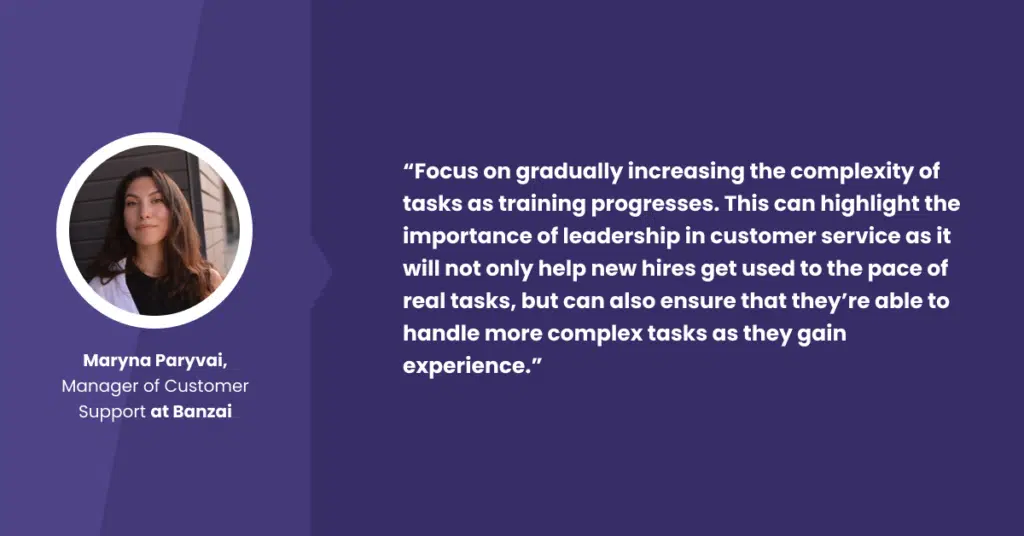
She also notes it’s important to ensure that hands-on training is provided wherever possible:
“This can help new hires get a better understanding of the tasks they’ll be performing. We aim to spend as much time as possible with new hires during their first few weeks, offering assistance and ensuring they don’t get stuck as they settle into their new role.”
Customer service leadership being available for agents that need assistance
Melissa Hughes says that providing your team with the answers they need in a timely manner is particularly important in remote work settings:
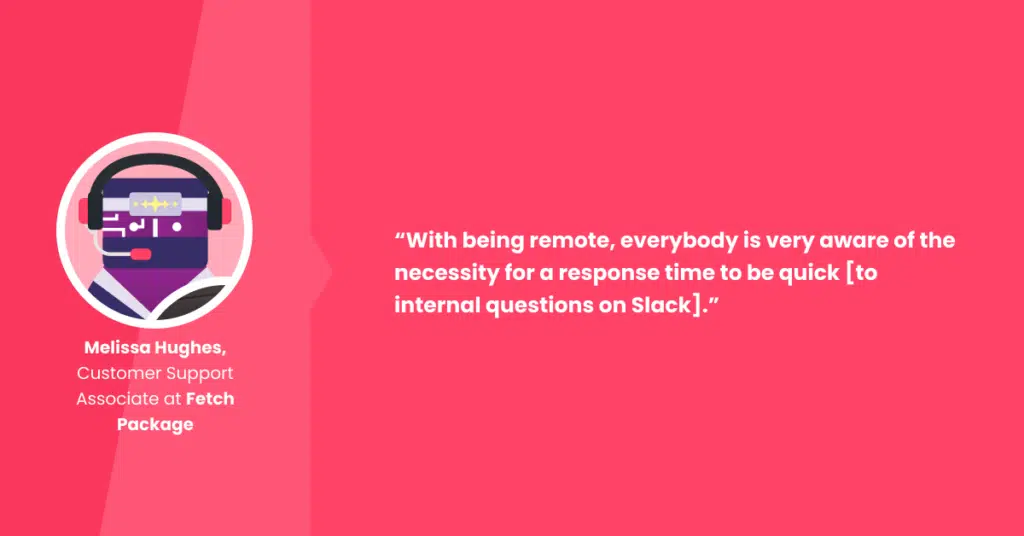
At Fetch Package, their support team aims to answer each other’s queries promptly in one designated Slack channel. Team managers and agents are always looking to lend an extra hand when someone’s stuck or unsure of how to fix a customer challenge.
Having rapid internal response time means faster customer replies. This is vital for new agents who should always have senior agents ready to respond to their questions. Talk about smooth and stress-free onboarding processes.
Trust and dependability among coworkers is also essential for fostering a great customer service culture. By applying these principles, you’ll avoid misunderstandings, accelerate growth, and make sure your support staff isn’t overwhelmed by having to know everything all at once. This is also one of the top customer service leadership skills you’ll need to develop.
Let your team stay autonomous
Sticking to a script is an easy fix for customer service teams who want to speed up their ticket resolution process.
But Magdalena Primo, Customer Support Supervisor at ID90 Travel, says that sticking to the script can take a toll on agents as it makes them invest more effort into their work:

Magdalena says she’s experienced this herself as she hasn’t felt she was being authentic with customers. Specifically, the lack of empathy made her feel as if she couldn’t help customers and would barely help her resolve issues. No personal satisfaction and no more intrinsic motivation to give your all for other tickets.
Empower your team!
You should be able to give your team [and customers] everything they need to succeed.
On this note, Duncan Wilson, Customer Service and Sales Manager at Mettrr and TruthEngine, says he created step-by-step guides for their customers to help them use their tool’s dashboard [and other features] properly so they could get the most out of it:

This has helped Duncan’s team reduce their number of support tickets and stay happier at work:
“My team is now only in action when our customers really need a human being on the phone. Helping customers solve these complex solutions is one of the most satisfying aspects of our job. So my team gets more job satisfaction and doesn’t need to be involved in repetitive, mundane tasks.”
Tip: But customer service can sometimes feel like a thankless task so it’s important to share the love with your team. Whether it’s a lovely review from a customer or an impressive renewal rate, Duncan recommends making a point of sharing it with the wider team in a company meeting or Slack channel.
Set clear expectations
Larry Barker, Senior Manager, Customer Support Operations at Articulate, says that when you’re leading a customer support team, few things are more important than setting clear expectations:
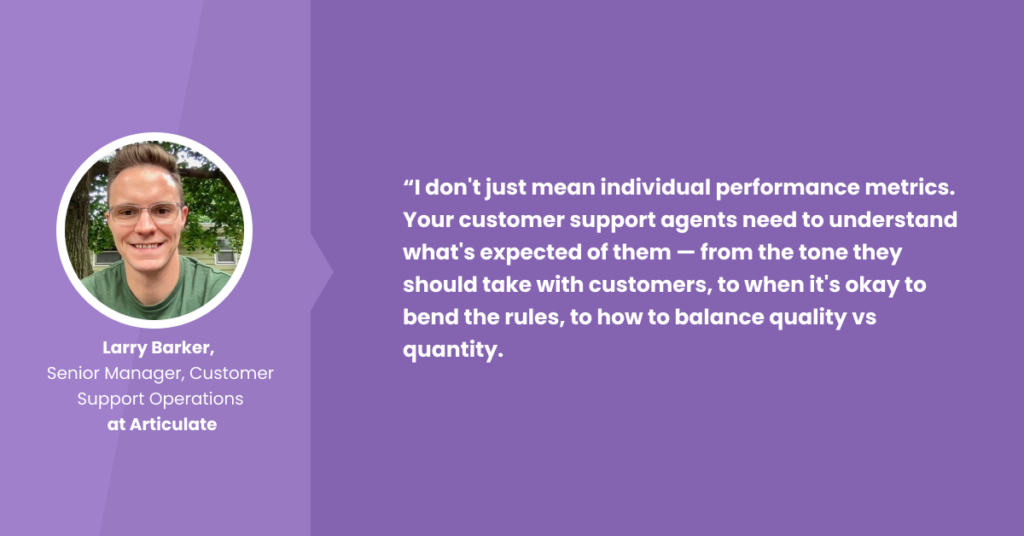
As a support leader, it’s your job to remove the ambiguity and to give your team the confidence they need to do their jobs well. Customer support is a stressful job — the tickets never stop coming. By setting clear expectations, you can help put your team’s mind at ease so they can do their best work and serve customers well.”
Develop reinforcement mechanisms
Zoe Koven, Senior Director of Innovation & Customer Advocacy at Zendesk, highlights the value of building reinforcement mechanisms to support change:
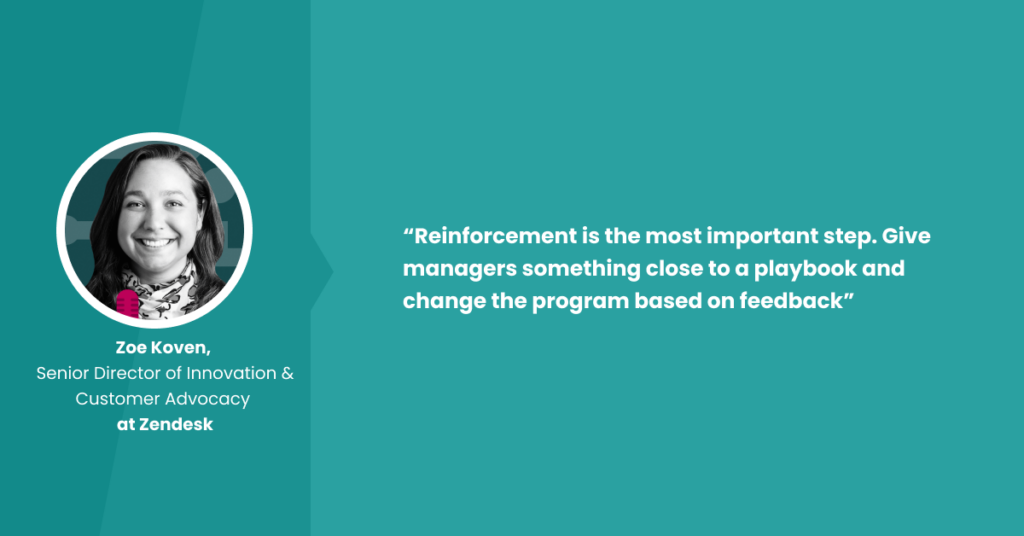
What does this look like in practice?
Whenever a change happens, customer service leadership will have to adapt their processes to the needs of customer service team members. This largely depends on the size of your team and how complex the change is.
One of the best examples of leadership in customer service comes from Zendesk. When they changed from email-based messaging to live chat, Zoe and her team actively provided managers with all the support they needed to guide their staff members through the change. Every leader received the exact metrics and even coaching points they had to consider to improve the team’s performance.
One huge change they adopted was a daily standup meeting. Every leader would gather and communicate the information their team needed on customer issues and needs as well as what it took to improve customer experience. Gathering data and careful planning made everyone’s job easier.
Note: When adopting this approach, you might see a dip in service levels in the first weeks. But it’s all a matter of time. Successfully managing change will speed up things and keep customer satisfaction high.
Limit the number of agents per customer service leader
If you’re looking to maximize your customer service team’s efficiency, you should consider limiting the number of agents per manager. This tactic ensures that each agent gets the attention and guidance they need.
Having too many agents per manager can lead to a number of issues. For example, customer service leadership might feel overwhelmed by the sheer number of agents they have to manage. Hence, they won’t be able to provide them with proper support for handling tasks and customer interactions. This can lead to a drop in morale and a decrease in agent productivity.
Limiting the number of agents per manager also allows you to provide more personal attention and recognize each individual. With fewer agents, a leader can focus on helping agents with their individual needs, such as providing soft skills training or helping them deliver better results. This type of personalized help makes for effective leadership in customer service that will foster a better customer service experience.
To determine expectations, Stephanie Wohl, Head of Support at Channable, says that having “10 full-time employees under one person is enough.” For larger teams where you’ve got as many as 2000 agents under one department, customer service team leaders should be able to oversee 15-20 agents.
Bonus: Make it a responsibility for your whole team!
In a previous talk we had with Mara Vicente, Vice President of Customer Support at Pipedrive, she revealed that every team member [e.g. marketer, engineer, sales representative] spends time shadowing a support teammate and handling tickets in their first few weeks.
This technique allows every department to see the impact of their work and get a better understanding of customer needs. Plus, they get to practice their communication skills on top of all that and they start to build some initial relationships with the support colleagues.
Let’s take a product marketer as an example. Solving tickets can offer them insights into customers’ real issues. Product marketers can then use this knowledge to identify potential issues with the product or uncover areas of improvement. They can then use this feedback to inform product and service design, advertising, or even customer onboarding and education.
Where to start
Take the time to apply these leadership customer service tips with your teams. Decide what your most pressing challenges are and prioritize your efforts accordingly.
For instance, if you need to improve your manager-agent feedback process, limit the number of agents you dedicate to every person in a customer service leadership position. Or, if you just want to make your team’s job easier, aim to set clearer expectations or offer better assistance to agents whenever they need it.


